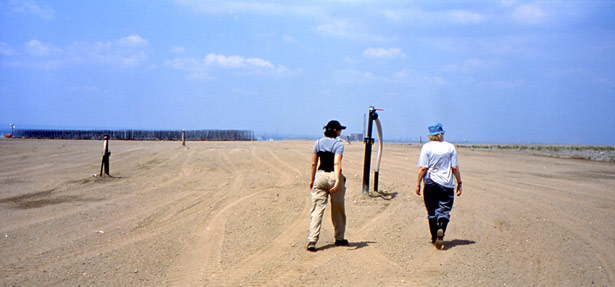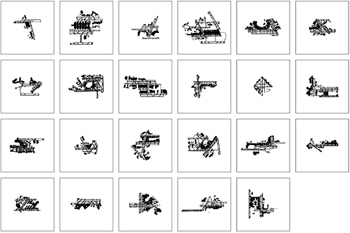An international symposium on Instant Urbanism, Hospitality and Accelerated History.
August 3rd – 9th 2009
Deadline for registration: Monday, July 20th, 2009
http://www.blauwehuis.org/
Out of The Blue is an international symposium organized by The Blue House (Het Blauwe Huis) focusing on three main navigational strands in understanding experimental communities: Instant Urbanism, Hospitality and Accelerated History. Out of The Blue is as a discursive forum where a number of investigative questions will be articulated via workshops, intense dialogues, in-conversations, study sessions, public deliberation plenaries, performances, and discussions with a number of guests on stage.
The initiator and main organizer is The Blue House, a four-year durational project initiated in IJburg, a new city extension of Amsterdam. IJburg is a major new urban district being developed on a cluster of man-made islands to the east of Amsterdam city centre. The whole development is governed by a highly detailed plan, the implementation of which is strictly regulated.
In 2005, artist Jeanne van Heeswijk arranged for a large villa in housing ‘Block 35’ to be taken off the private market and be re-designated as a space for community research, artistic production and cultural activities. In cooperation with Dennis Kaspori and Hervé Paraponaris The Blue House has acted as a centre for artistic and cultural production and research into what happens when such a radical approach to urban planning and community development is employed.
Out of The Blue will take place in the future ‘Activity Centre’ on the island presently under construction. The still concrete structure will be used as a temporal public faculty, a 50-room motel and an amphitheatre. The design is made by Maartje Dros and Francois Lombarts.
The curator of the symposium is Yane Calovski. It is part of Blue House project ‘Parade of Urbanism’ from Jeanne van Heeswijk and Dennis Kaspori in collaboration with Floris van Heynsbergen.
Symposium program:
Instant Urbanism: All for the love of Instant Urbanism
Organized with Ana Dzokic and Marc Neelen (STEALTH.unlimited, Rotterdam / Belgrade).
‘All for the love of Instant Urbanism’ brings together a group of people involved with and troubled by the necessity for a more future oriented instant creation and collectivity in the city. It blends a workshop, performance and discussions with a number of guests on stage, while setting out for the slippery grounds of even newer horizons.
Participants will include: Tor Lindstrand and Mårten Spångberg, International Festival, Stockholm, Emiliano Gandolfi, Cohabitation Strategies, independent curator and architect, Rotterdam, Dubravka Sekulic, Belgrade / Jan van Eyck Academy, Maastricht / Santiago Cirugeda, Recetas Urbanas, Sevilla.
Hospitality: Hospitality, Privacy, Place
Organized with Dr. Johan Siebers (Institute of Germanic & Romance Studies School of Advanced Study, University of London).
‘Hospitality, Privacy, Place’ is a two-day workshop that will explore the dialectic between these concepts in the context of the question what it means to build and develop a community that can be a mirror of Europe, both mediating and shaping its course.
Participants will include: Peter Thompson, Sheffield University (concrete utopias), Aneta Krzemien, University of Central Lancashire (public dialogue), Volker Schneider, Speedliner Co. and Ernst Bloch Assoziation, Bochum (concrete utopia, urbanization), Maaike Engelen, London (psychoanalysis as cultural critique).
Accelerated History: Is Time Enough? Duration, Location and Accelerated Histories
Organized with Dr. Paul O’Neill (artist – curator and GWR Research Fellow in Commissioning with Situations, University of the West of England, Bristol).
This strand of the symposium takes a speculative look at how duration and the evolutionary process of time is conceived of as part of new cumulative approaches to artistic, organizational and curatorial praxis in response to a specific locations and contexts. Centered around a series of intense dialogues and in-conversations, this strand aims to unpack key issues relating Durational approaches to Participatory Praxis, Collaboration and Play, Communities and Social Engagement, Organizational Models and Networks, Critical Writing and Pedagogy.
Participants will include: Sally Tallant (Head of Programmes, Serpentine, London) and Jonathan Banks (Chief Executive, ixia – the UK national public art think-tank), curator Sophie Hope (co-founder of curatorial duo B+B, London) and Amsterdam based writer-curator Eva Fotiadi, artists Barbara Holub & Paul Rajakovics (Transparadiso, Vienna), Christoph Schaefer (Park Fiction, Hamburg), and Mick Wilson (Dean of GradCam, Dublin), writer and media theorist Ned Rossiter (author of ‘Organized Networks’) and Paul O’Neill with a writing workshop on duration led by Maria Fusco (Writer and Director of Art Writing, Goldsmiths, London).
Out of The Blue has been developed by The Blue House and a number of partner institutions including: Locating the Producers – an on-going collaborative research initiative between Situations at the University of the West of England, Bristol, ProjectBase in Cornwall and Dartington College of Arts / University College Falmouth and led by Dr. Paul O’Neill (www.situations.org.uk/research_ltp.html) and ECREA – European Communication Research and Education Association – Philosophy of Communication.

